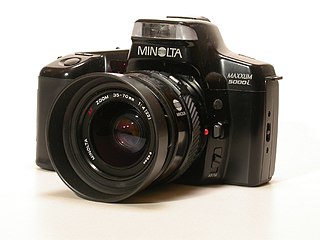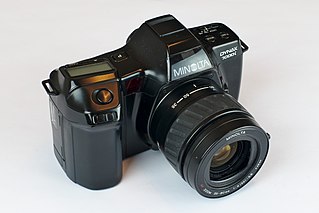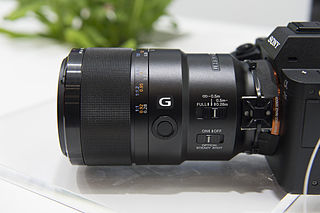Related Research Articles

Konica Minolta, Inc. is a Japanese multinational technology company headquartered in Marunouchi, Chiyoda, Tokyo, with offices in 49 countries worldwide. The company manufactures business and industrial imaging products, including copiers, laser printers, multi-functional peripherals (MFPs) and digital print systems for the production printing market. Konica Minolta's Managed Print Service (MPS) is called Optimised Print Services. The company also makes optical devices, including lenses and LCD film; medical and graphic imaging products, such as X-ray image processing systems, colour proofing systems, and X-ray film; photometers, 3-D digitizers, and other sensing products; and textile printers. It once had camera and photo operations inherited from Konica and Minolta but they were sold in 2006 to Sony, with Sony's Alpha series being the successor SLR division brand.

Minolta Co., Ltd. was a Japanese manufacturer of cameras, camera accessories, photocopiers, fax machines, and laser printers. Minolta Co., Ltd., which is also known simply as Minolta, was founded in Osaka, Japan, in 1928 as Nichi-Doku Shashinki Shōten. It made the first integrated autofocus 35 mm SLR camera system. In 1931, the company adopted its final name, an acronym for "Mechanism, Instruments, Optics, and Lenses by Tashima".

The Minolta MAXXUM 7000 35 mm SLR camera was introduced in February 1985. It was the first camera to feature both integrated autofocus (AF) and motorised film advance, the standard configuration for later amateur and professional single lens reflex cameras.

Sony α is a brand of digital camera. This line has been active since 2006, building upon the Konica Minolta camera technologies, whose assets were acquired by Sony.

The Maxxum 7D, labelled Dynax 7D in Europe/Hong Kong and α-7 Digital in Japan and officially named "DG-7D", is a 6.1 megapixel digital single-lens reflex camera, or DSLR, produced by Konica Minolta. It was the top model of their DSLR range; the Maxxum/Dynax 5D consumer-grade model was the other.

The Minolta AF Zoom 70–210mm f/4 lens is an autofocusing telephoto photographic lens compatible with cameras using the Minolta AF lens mount.

The Minolta A-mount camera system was a line of photographic equipment from Minolta introduced in 1985 with the world's first integrated autofocus system in the camera body with interchangeable lenses. The system used a lens mount called A-mount, with a flange focal distance 44.50 mm, one millimeter longer, 43.5 mm, than the previous SR mount from 1958. The new mount was wider, 49.7 mm vs. 44.97 mm, than the older SR-mount and due to the longer flange focal distance, old manual lenses were incompatible with the new system. Minolta bought the autofocus technology of Leica Correfot camera which was partly used on the a-mount autofocus technology. The mount is now used by Sony, who bought the SLR camera division from Konica Minolta, Konica and Minolta having merged a few years before.

The Minolta Maxxum 4 35mm SLR camera was introduced in 2002. Konica Minolta has discontinued production of this model but maintains information on it in its website.

Minolta AF 35mm f/1.4 lens is a camera lens that was introduced by Minolta in 1987, and revised in 1998 as Minolta AF 35mm f/1.4 G New. In 2005, Konica Minolta announced the Konica Minolta AF 35mm f/1.4 G (D) with revised optics, mechanics and distance encoder. This version was never released, but saw life as Sony α 35mm f/1.4 G (SAL-35F14G) in 2006, released by Sony. The 35mm f/1.4 G is compatible with cameras using the Minolta AF and Sony α lens mounts.

This article details lensesfor single-lens reflex and digital single-lens reflex cameras. The emphasis is on modern lenses for 35 mm film SLRs and for "full-frame" DSLRs with sensor sizes less than or equal to 35 mm.

The Minolta 5000i is a 35mm single-lens reflex camera belonging to the second generation of bodies in Minolta's autofocus SLR system, fitting between the cheaper 3000i and the more expensive, semi-pro 7000i, and replacing the 5000. The "i" in the names of the new camera range stood for "intelligence". Like the 7000i, the 5000i supported Minolta's Creative Expansion Cards, plug-in electronic modules that added new functionality to the camera.

The Minolta Dynax 7000i is a 24x36mm auto-focus SLR camera, introduced by Minolta in 1988. It was sold in North America as Maxxum 7000i and in Japan as α-7700i.

Sony α100 (DSLR-A100) is the first digital single-lens reflex camera (DSLR) marketed by Sony in 2006. It is the successor to the previous Konica Minolta DSLR models through Sony's purchase of the Konica Minolta camera division. The α100 retains a similar body design and claimed improvements on Konica Minolta's Anti-Shake sensor-shifting image stabilization feature, renamed Super SteadyShot. It uses a 10.2 megapixel APS-C sized CCD sensor. Another notable feature inherited from Konica Minolta is Eyestart, which provides for automatic autofocus activation by detecting the presence of the photographer's eye on the viewfinder, thus quickening the camera's response.

The E-mount is a lens mount designed by Sony for their NEX and ILCE series of camcorders and mirrorless cameras. The E-mount supplements Sony's α mount, allowing the company to develop more compact imaging devices while maintaining compatibility with 35mm sensors. E-mount achieves this by:
A-mount or A mount may refer to:
Alpha 7 (α7) or Alpha-7 (α-7) may refer to:

Rokkor was a brand name used for all Chiyoda Kōgaku Seikō and later Minolta lenses between 1940 and 1980, including a few, which were marketed and sold by other companies like Leica. The name was derived from the name of Rokkō (六甲山), a 932 metre (3058') high mountain, which could be seen from the company's glass-making and optics factory at Mukogawa near Osaka, Japan. The company's founder Kazuo Tashima wanted the name to symbolize the high quality in optics.

The Sony FE 90mm F2.8 Macro G OSS is a full-frame macro prime lens for the Sony E-mount, announced by Sony on 4 March 2015.
References
- ↑ "αシリーズ用新交換レンズ『コニカミノルタ AF 35mm F1.4G (D)』(仮称)を開発" [New interchangeable lens for α series: Development of "Konica Minolta AF 35mm F1.4 G (D)" (tentative name)] (in Japanese). Konica Minolta, Inc. 2005-07-15. Retrieved 2015-07-08.
- ↑ "Development of "Konica Minolta AF 35mm F1.4 G (D)" - Interchangeable Lens for SLR Cameras of the Dynax/Maxxum Series". Konica Minolta Photo Imaging, Inc. 2005-07-15. Retrieved 2015-07-09.
- ↑ "Konica Minolta AF 35 mm F1.4G D lens - Konica Minolta press release: Development of "Konica Minolta AF 35mm F1.4G (D)"". dpreview. 2005-07-15. Retrieved 2015-07-08.
- 1 2 3 Paul, Matthias R. (2013-03-03) [2006]. "A-Bajonett-Objektiv-IDs / A-Mount Lens IDs, Welche ID hat welches Objektiv wirklich?" [A-mount lens IDs - Which lenses are verified to have which IDs?] (in German). Minolta-Forum. Archived from the original on 2015-07-11. Retrieved 2015-07-09.
- ↑ Minolta Co., Ltd. / Minolta Europe GmbH, Osaka / Langenhagen (2003). Faltblatt für Kunden der Dynax 9 mit SSM-Objektiven: For users of the Dynax 9 / Pour les utilisateurs du Dynax 9 / Für Benutzer der Dynax 9 / Para usuarios de la Dynax 9 (in German). Minolta-Forum. 9222-2682-22 P-A307. Archived from the original on 2016-03-30. Retrieved 2011-01-08. Additional archives: 2016-04-02.
- ↑ Minolta Co., Ltd., Osaka. Minolta-Hotline-Fax vom 2004-05-10, 2 Seiten: Dynax/Maxxum 9/9Ti – SSM Lens Update Camera Instruction Manual (in German). Minolta-Forum. Archived from the original on 2016-03-30. Retrieved 2011-01-08. Additional archives: 2016-04-02.
- ↑ Paul, Matthias R. (2009-02-23). "Petition zur Wiederaufnahme des SSM-Umrüstservice" (in German). Minolta-Forum. Archived from the original on 2016-05-16. Retrieved 2011-01-08.
- ↑ Wendt-Fröhlich, Daniel (2009-04-28). "Die weltweit letzten 200 SSM-/ADI-Umrüstsätze können seit April 2009 von Runtime verbaut werden". Erfolgsmeldung zur Petition bzgl. der Wiederaufnahme des Umrüstservice im Minolta-Forum vom 2009-04-28 (in German). Minolta-Forum. Archived from the original on 2016-05-20. Retrieved 2011-01-08.